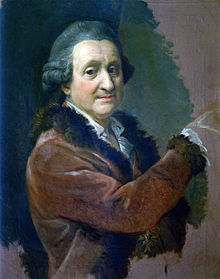Pompeo Batoni
Pompeo Girolamo Batoni (also: Battoni ; * February 5, 1708 in Lucca , † February 4, 1787 in Rome ) was an Italian painter . Batoni is considered to be the inventor of the tourist portrait . He developed this type of portrait for English tourists in Rome.

Life
Batoni, a student of Sebastiano Conca and Agostino Masucci , raised to the nobility by Emperor Joseph II , died on February 4, 1787 in Rome. He was highly valued in his time and placed in line with Anton Raphael Mengs . His career as a freelance painter began in anecdotal form in 1739. During a rain shower, Gabrielli di Gubbio , a count from the Umbrian Baccaresca, sought protection from the storm under a portico of the Roman Conservatory's Palace. Here he met the artist who made some drawings there. They started talking and the count accompanied the artist into his studio. Impressed by what was shown, the count commissioned him to paint an altarpiece for the Roman church of San Gregorio Magno al Celio . His first significant work has been preserved there as the left side altar to this day.
At first he tried to fight the mannerist tendency of his time based on antiquity and the study of Raphael , but did not get beyond an academic attitude and superficial grace.
The most famous of his works are: the penitent Maria Magdalena (around 1742, oil on canvas, formerly in the Gemäldegalerie in Dresden, war lost in the bombing on February 13, 1945), a holy family, Thetis, receiving Achilles back from the centaur Chiron, Vulkan in the smithy, the abstinence of Scipio (in the Hermitage in St. Petersburg), the family of Darius before Alexander (painted for the King of Prussia), the Sacred Heart adored by the four parts of the world (a large altar panel, 1780 for a newly built church in Lisbon), the ceiling of the Colonna Gallery in Rome, the portraits of Popes Benedict XIV. , Clement XIII. and Pius VI. , of Emperor Joseph II and his brother Leopold von Toscana (in the Belvedere in Vienna). A painting is attributed to him in the Roman church of Sant'Eligio de 'Ferrai .
The location of the paintings or collections relates to the year 1889. These can be located elsewhere today (the painting of Joseph II and his brother is now in the Kunsthistorisches Museum in Vienna).
reception

Batoni was very successful with his magnificent pictures for over four decades. British travelers complained about the high prices he was asking for portraits. In the second half of the 18th century, the prevailing taste changed, which can also be seen in Batoni's late work from 1780 onwards. In the 19th and 20th centuries he was no longer part of the canon of great painters. "Geniuses" (for example Caravaggio in the early baroque) were valued more highly than the "experts" of late baroque representational art. On the occasion of his 300th birthday in 2008, however, at least three important exhibitions took place (Houston 2007/08, London 2008, Lucca 2008/09).
The journalist, writer and painter Joachim Fernau expressed himself humorously and with ironic derogation . He considered Bat (t) oni, who was probably not able to decide on the spelling of his own name during his life, to be a luminary who was not too good at producing terrible trash - precisely that penitent Maria Magdalena.
literature
- Catalog raisonnés
- Anthony M. Clark: Pompeo Batoni - A complete catalog of his works with an introductory text . New York University Press, New York 1985, ISBN 0-8147-1397-1 (English).
- Edgar Peters Bowron: Pompeo Batoni - A complete catalog of his paintings . Yale University Press, New Haven / London 2016, ISBN 978-0-300-14816-9 (English, 2 volumes, over 480 paintings and 250 drawings).
- Other literature
- Ernst Emmerling: Pompeo Batoni. His life and work . Dissertation Cologne 1932.
- Edgar Peters Bowron, Peter Björn Kerber: Pompeo Batoni. Prince of Painters in Eighteenth-Century Rome . Yale University Press 2007 (catalog for the exhibition in Houston, Museum of Fine Arts).
Web links
Individual evidence
- ↑ Andrea M. Kluxen: The end of the state portrait. The importance of English painting for German portraits 1760–1848. Fink, Munich 1989, pp. 95f.
- ↑ Christopher Hibbert: The Grand Tour . Guild Publishing, London 1987, pp. 180 (English).
- ↑ Harald Keller u. a .: The art of the 18th century (= Propylaea art history . Volume 10 ). Propylaeen Verlag, Berlin 1971, p. 343, 352 (text by Peter Eikemeier).
- ↑ Joachim Fernau: Where do you go to Raffael and other art stories . Ed .: Gabriele Fernau. 2nd Edition. Ullstein, Munich 2002, My reference (sic) of the "penitent Magdalena", p. 9-16 . Fernau had not even included the painter in the artist lexicon he was working on: Joachim Fernau: Knaur's Lexicon of Old Painting . Droemersche Verlagsanstalt Th.Knaur Nachf., Munich / Zurich 1958, p. 29 .
| personal data | |
|---|---|
| SURNAME | Batoni, Pompeo |
| ALTERNATIVE NAMES | Batoni, Pompeo Girolamo (full name); Battoni, Pompeo Girolamo |
| BRIEF DESCRIPTION | Italian painter |
| DATE OF BIRTH | February 5, 1708 |
| PLACE OF BIRTH | Lucca |
| DATE OF DEATH | February 4, 1787 |
| Place of death | Rome |

